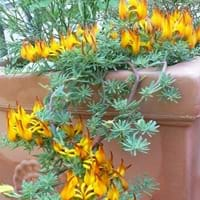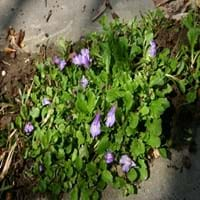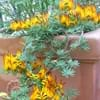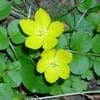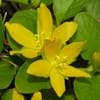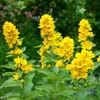Life Span
Perennial
Perennial
Origin
Canary Islands
Southeastern Asia, Nepal
Types
Not Available
Not Available
Habitat
Mediterranean region, mild coastal areas, shaded fields, Shaded sites, Well Drained
Coastal Regions, Cold Regions, Terrestrial
USDA Hardiness Zone
8-11
5-8
Sunset Zone
H1, 9, 15, 16, 17, 18, 19, 20, 21, 22, 23, 24
1a, 1b, 2a, 2b, 3a, 3b, 4, 5, 6, 7, 8, 9, 14, 15, 16, 17, 18, 19, 20, 21, 22, 23, 24
Habit
Prostrate/Trailing
Mat-forming
Flower Color
Red, Gold, Orange Red
White, Blue Violet
Flower Color Modifier
Bicolor
Bicolor
Fruit Color
Green
Not Available
Leaf Color in Spring
Gray Green, Silver
Green
Leaf Color in Summer
Gray Green, Silver
Green
Leaf Color in Fall
Gray Green, Silver
Green
Leaf Color in Winter
Light Green
Light Green
Leaf Shape
Spine-edged leaves
Lance shaped
Plant Season
Spring, Summer, Fall, Winter
Spring, Summer, Fall, Winter
Sunlight
Full Sun
Full Sun, Partial Sun, Partial shade
Type of Soil
Loam, Sand
Loam, Sand
The pH of Soil
Neutral, Alkaline
Neutral
Soil Drainage
Well drained
Well drained
Bloom Time
Spring, Late Spring, Early Summer, Summer
Late Spring, Early Summer, Summer
Tolerances
Drought
Drought
Where to Plant?
Ground
Ground
How to Plant?
Divison
Seedlings
Plant Maintenance
Medium
Low
Watering Requirements
Water Deeply, Water in morning to avoid prompting diseases, Water more frequently during periods of extreme drought
Average Water Needs, Do Not over Water, Never Over-water, Requires regular watering
In Summer
Lots of watering
Lots of watering
In Spring
Moderate
Moderate
In Winter
Average Water
Average Water
Soil pH
Neutral, Alkaline
Neutral
Soil Type
Loam, Sand
Loam, Sand
Soil Drainage Capacity
Well drained
Well drained
Sun Exposure
Full Sun
Full Sun, Partial Sun, Partial shade
Pruning
Cut or pinch the stems, Remove damaged leaves, Remove dead branches, Remove dead leaves
Prune if you want to improve plant shape, Remove damaged leaves, Remove dead leaves
Fertilizers
All-Purpose Liquid Fertilizer, Apply N-P-K
fertilize in growing season, Less fertilizing
Pests and Diseases
Aphids, Blight, Fusarium root rot, Mealybugs, Mites, Powdery mildew, Red blotch
Insects
Plant Tolerance
Drought, Full Sun, Heat And Humidity
Cold climate
Flower Petal Number
Single
Single
Foliage Texture
Fine
Fine
Foliage Sheen
Matte
Matte
Attracts
Aphids, Mealybugs, Mites, Spider Mites
Butterflies, Insects
Allergy
Not Available
Asthma
Aesthetic Uses
Borders, Formal Garden, Ground Cover
Beautification, Ground Cover, Landscape Designing, Showy Purposes, Used for decorating walls, fences, gates, hedges, etc.
Beauty Benefits
Not Available
Not Available
Environmental Uses
Air purification
Air purification, Food for insects, No fertilizer, pesticides, or herbicides needed, Prevent Soil Erosion
Medicinal Uses
Not Available
Cough
Part of Plant Used
Not Available
Whole plant
Other Uses
Used as Ornamental plant
Decoration Purposes, Employed in herbal medicine, Showy Purposes
Used As Indoor Plant
No
No
Used As Outdoor Plant
Yes
Yes
Garden Design
Container, Hanging Basket, Mixed Border, Rock Garden, Wall
Alpine, Edging, Groundcover, Rock Garden, Wall
Botanical Name
LOTUS berthelotii
MAZUS reptans
Common Name
Parrot's Beak
Winged Pea
Creeping Mazus
In Hindi
Parrot's Beak
जीव Mazus
In German
Papageienschnabel
Creeping Mazus
In French
Le Bec de perroquet
Creeping Mazus
In Spanish
Pico de loro
arrastramiento Mazus
In Greek
Ράμφος παπαγάλου
υφέρπουσα Mazus
In Portuguese
Bico do Papagaio
Creeping Mazus
In Polish
Dziób papugi
Creeping Mazus
In Latin
Parrot rostri
reptilia Alba
Phylum
Streptophyta
Anthophyta
Class
Not Available
Dicotyledonae
Order
Fabales
Scrophulariales
Family
Fabaceae
Scrophulariaceae
Clade
Angiosperms, Eudicots, Rosids
Angiosperms, Asterids, Eudicots
Subfamily
Faboideae
Mimuloideae
Number of Species
Not Available
Importance of Parrot's Beak and Creeping Mazus
Want to have the most appropriate plant for your garden? You might want to know the importance of Parrot's Beak and Creeping Mazus. Basically, these two plants vary in many aspects. Compare Parrot's Beak and Creeping Mazus as they differ in many characteristics such as their life, care, benefits, facts, etc. Every gardener must at least have the slightest clue about the plants he wants to plant in his garden. Compare their benefits, which differ in many ways like facts and uses. The medicinal use of Parrot's Beak is Not Available whereas of Creeping Mazus is Cough. Parrot's Beak has beauty benefits as follows: Not Available while Creeping Mazus has beauty benefits as follows: Not Available.
Compare Facts of Parrot's Beak vs Creeping Mazus
How to choose the best garden plant for your garden depending upon its facts? Here garden plant comparison will help you to solve this query. Compare the facts of Parrot's Beak vs Creeping Mazus and know which one to choose. As garden plants have benefits and other uses, allergy is also a major drawback of plants for some people. Allergic reactions of Parrot's Beak are Not Available whereas of Creeping Mazus have Asthma respectively. Having a fruit bearing plant in your garden can be a plus point of your garden. Parrot's Beak has no showy fruits and Creeping Mazus has no showy fruits. Also Parrot's Beak is flowering and Creeping Mazus is flowering. You can compare Parrot's Beak and Creeping Mazus facts and facts of other plants too.
